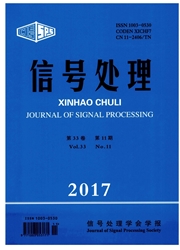

 中文摘要:
中文摘要:
已有的基于拟合优度频谱感知算法具有较好检测性能的前提是假设感知时主用户信号保持不变,这在认知无线电中是很少见的。该文提出一种适用于多天线认知系统的拟合优度盲频谱感知算法。首先,计算不同天线间接收信号的相关系数;其次,对相关系数进行适当的非线性变换使其服从学生分布;最后,对变换后的新序列使用侧重右尾检验的Anderson-Darling(RAD)准则进行拟合优度检验。理论分析和仿真表明,所提算法不需要任何先验信息,与基于最大最小特征值之比(MME)、基于协方差绝对值(CAV)、Anderson-Darling(AD)检测算法以及噪声方差已知的能量检测相比,所提算法具有更好的检测性能。
 英文摘要:
英文摘要:
The performance of the existing spectrum sensing algorithm based on goodness of fit (GOF) testing is only excel- lent when the primary signal is static during sensing interval, which is a very rare case in cognitive radio. For the use in the real Multi-antenna cognitive radio scenarios, a new spectrum sensing based goodness of fit in Multi-antenna cognitive radio is proposed in this paper. Firstly, the correlation coefficients between each antenna are calculated; secondly, the author makes appropriate non-linear transformation of every correlation coefficient so as to obey Student' s t-distribution; finally, the Right-tail Anderson-Darling (RAD) rule is adopted. Both analysis and numerical results show that the proposed method does not need any prior information and outperforms the Anderson-Darling sensing method, the Ratio of Maximum eigenval- ue to Minimum eigenvalue (MME) method, the Covariance absolute value (CAV) method and ED method with noise vari- ance known in the same simulation environment.
 同期刊论文项目
同期刊论文项目
 同项目期刊论文
同项目期刊论文
 期刊信息
期刊信息
